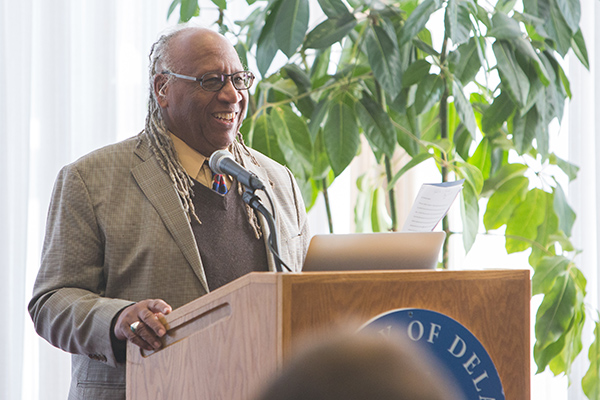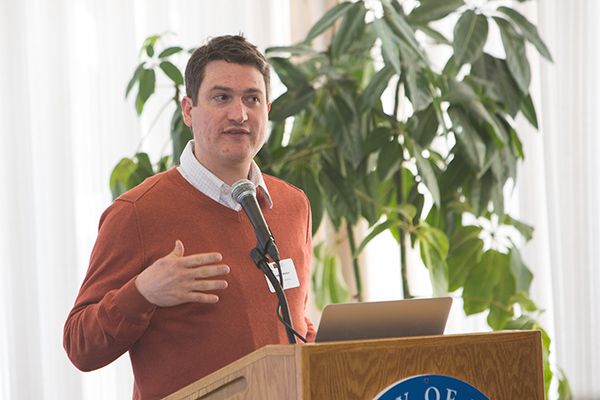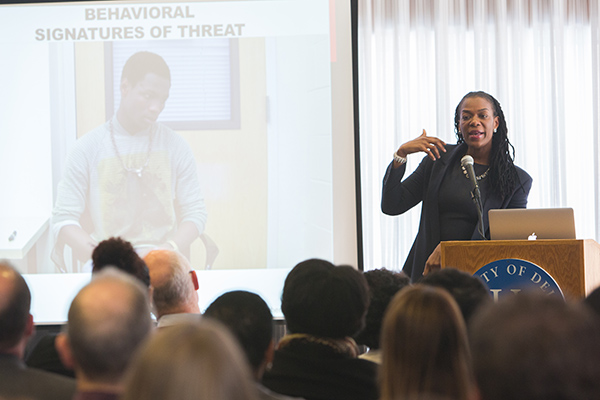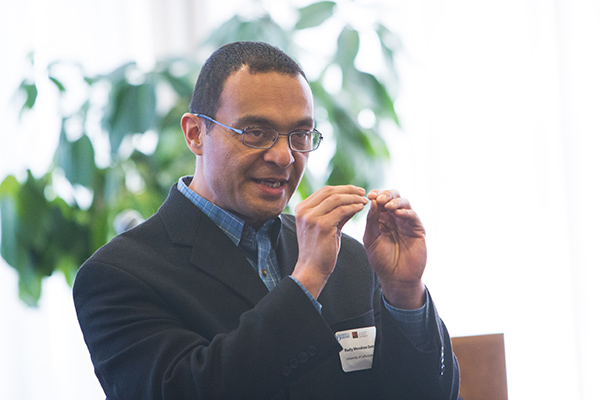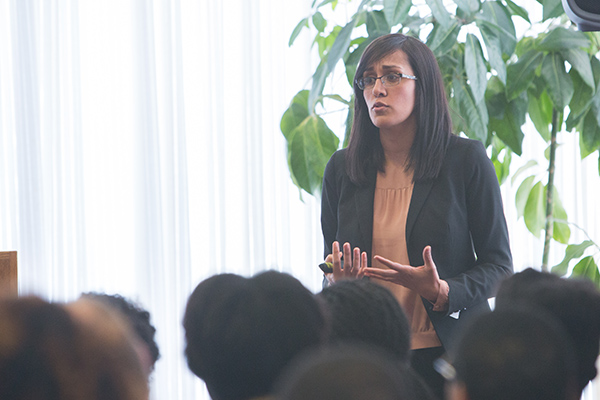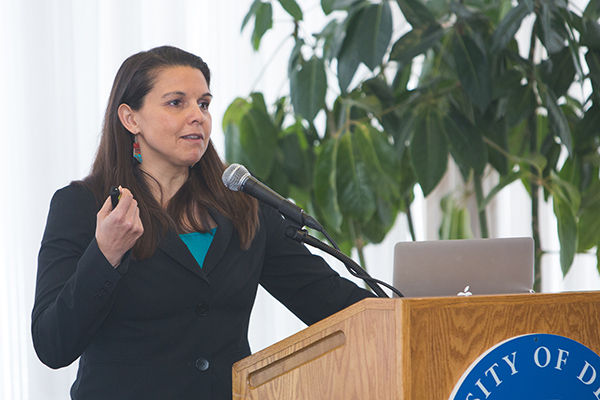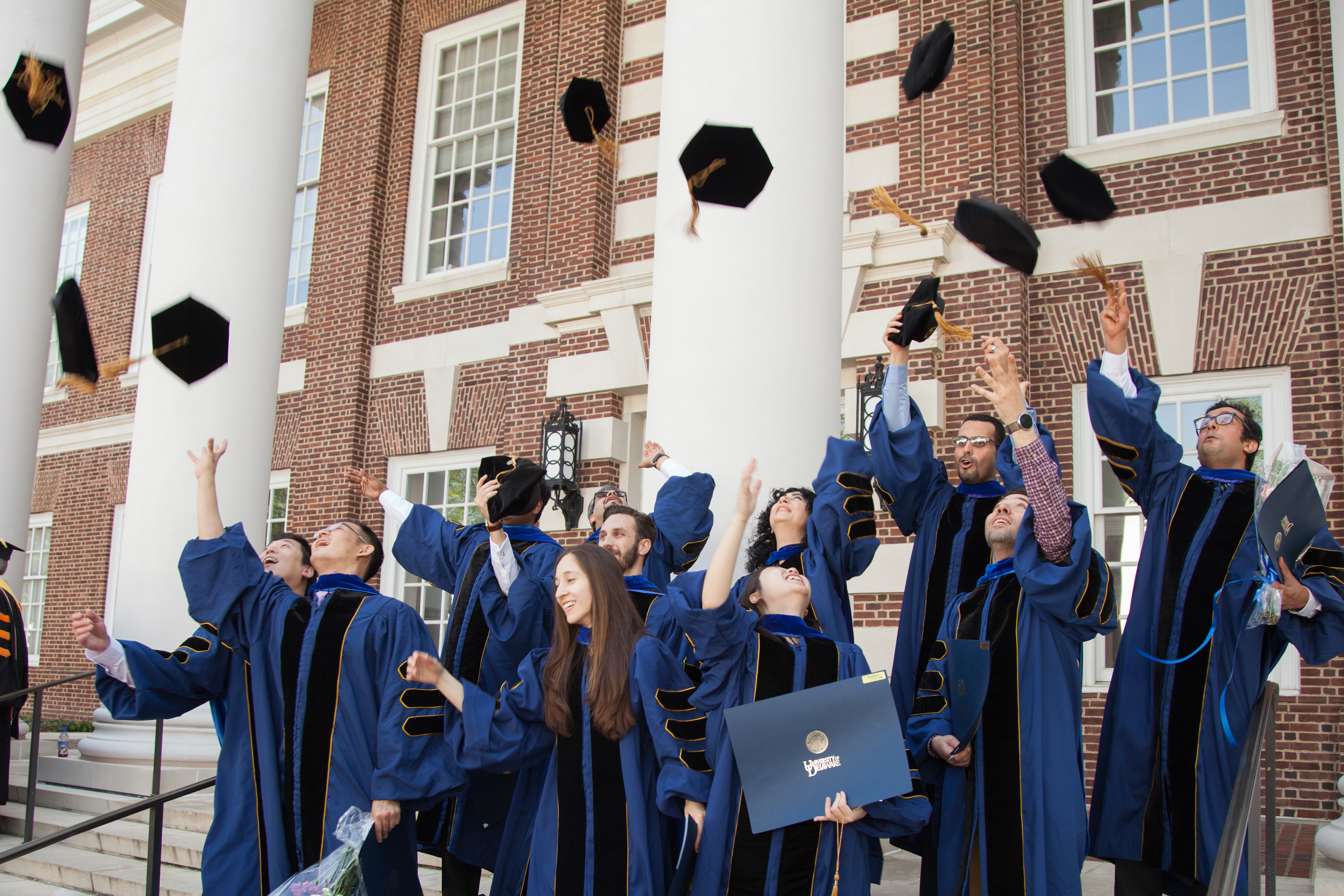Student Success Symposium
Researchers discuss how sense of belonging boosts student success rate
3:21 p.m., Feb. 24, 2015--On the great dance floor of human interaction, not even Fred Astaire and Ginger Rogers always got it right. They stepped on each other's toes, twirled when they should have swirled and sometimes underestimated each other.
They are iconic names in dance not because they were always perfect, but because they worked out many differences and did a lot of retakes.
Campus Stories
From graduates, faculty
Doctoral hooding
Strong, productive relationships -- whether business or personal in nature -- require give, take and a good bit of flex. Finding ways to build that kind of synergy in an academic setting with students from increasingly diverse backgrounds was the focus Thursday of a daylong symposium hosted by the University of Delaware's Center for the Study of Diversity.
The Perkins Student Center Gallery was packed for the event, the first in a series meant to help the University support the academic goals of three categories of students -- first-generation, low-income and under-represented minorities.
James Jones, professor in the Department of Psychological and Brain Sciences and director of the center, opened the day with data on UD's population. Using an index that measures diversity from 0 (no diversity) to 1 (maximum diversity), UD has a score of 0.36, Jones said, "which is closer to zero than to one."
But that number has been rising, he said, and the entering class has an index of 0.50.
UD has made diversity a priority, but the campus culture must change in ways that confirm its commitment. If the University does not retain those students and help them reach graduation, "all that recruiting is for naught," Jones said.
How to make meaningful change was the focus of the rest of the day, as five researchers showed how everything from addressing a student by name to more comprehensive interaction with families and communities can have significant and lasting impact on "at-risk" students.
Fitting in
Gregory Walton, assistant professor of psychology at Stanford University, showed how small efforts can relieve some of the things students worry about most, the things that may wear them down as they pursue their academic goals:
- Do I belong?
- Am I smart enough?
- Does this matter?
Brief, 15-minute interventions can help students resolve such concerns, Walton said -- not tricks or magic bullets that work in every situation, but conversations or encounters that address a student's specific needs.
For example, upper-class students who share their stories can prevent or address misunderstandings and reassure students that all newcomers have similar “do-I-fit-in” worries.
Walton said studies showed that almost all students -- no matter their race -- felt left out in social situations at one time or another, but not all interpreted that as discriminatory treatment.
The transition to college can be easier if students have some idea what to expect before they arrive on campus, he said. That can be done in high school programs or through online pre-enrollment materials, he said.
Walton pointed to data from Stanford that showed those efforts had greater impact on student retention than $3,500 incentives to stay in school.
He likened those measures to engine oil. They don't replace other interventions, they just help them work better.
Valerie Purdie-Vaughns of Columbia University said students can miss important links and opportunities because they don't know what support is available to them.
As an undergraduate and the first in her family to attend college, she said she didn't know professors had offices. She thought they came to campus, taught their classes and went home. She didn't know she could meet with them so she never did.
Now, as an associate professor of psychology at Columbia, she studies the impact stereotypes have on student achievement and how intervention -- helping them reduce stress and deal with perceived threats -- can help.
In one study, Purdie-Vaughns said seventh-graders who did a simple, 15-minute writing exercise that asked them to explain things that were important to them did better academically over the course of several years than those who had no exercise.
"A small psychological intervention could have a large impact," she said.
Supportive relationships
Rudy Mendoza-Denton, associate professor of psychology at the University of California, Berkeley, studies race-based rejection sensitivity and how institutions can help students develop a sense of belonging.
Mendoza-Denton said relationships matter at every level. Students need connections within their own groups and need good connections with other groups, too.
He recommends allowing ethnically centered groups, though some fear that students who join such groups are moving away from diversity toward Balkanization.
Research suggests that students who develop supportive relationships within their own ethnic group develop a sense of belonging to the overall community that helps them navigate when with other groups.
"One person can contribute to that sense of belonging," he said. "Maybe this place is not so cold and clammy after all."
Mentors have similar relationship struggles, he said, sometimes fearing that things they say will be perceived as racist. But those who work to build bridges can plant a seed that allows a student to see themselves as a scientist or as a potential leader in another field.
Impact of cultural values
A student-mentor team -- Rebecca Covarrubias, a postdoctoral researcher at UD, and Stephanie Fryberg, associate professor of psychology and American Indian studies at the University of Washington -- discussed their research on the impact of cultural values on student performance.
Fryberg, who grew up on a reservation, said a "State of Emergency" had been declared in the education of Native American students in Washington, and 40 years after that declaration no progress had been made.
Their work focused on changes made in two schools that had about 80 percent Native American students, high poverty rates and ranked in the bottom 5 percent of Washington state. Officials had invested millions with little improvement, but now they changed their approach to students and their families.
They started with the assumption that nothing was wrong with the students, Fryberg said.
The work included reframing the value of education to the tribe and community, highlighting the values of their culture and inviting families and elders into the schools.
That was a critical shift. Where much of the middle-class, European culture in the United States is focused on independence and personal achievement, other cultures -- Latin American cultures and Native American cultures, for example -- are based on interdependent values, achievement for the benefit of family and community, they said.
Some students in such cultures may feel guilty staying in university programs because their families are struggling to make ends meet and they are not contributing to meeting those needs.
When education is reframed as an ultimate benefit for the family and community, its value is embraced more readily.
A commitment to the university's role as a "public good" is essential, Fryberg said.
"We have to move beyond blaming students and teachers," Covarrubias said. "And we can do it with very subtle refinements."
Change at UD
During lunch, small groups of students, faculty and administrators discussed how the research could inform change at UD.
Keeley Powell, director of recruitment and diversity in the University's Office of Graduate and Professional Education, said she grew up in a mostly white community, where she and her family felt racial hostility. UD has the highest amount of diversity she has lived in, she said.
In departments and classes where diversity is low, minority students sometimes feel they are expected to represent the views of their entire race or population. In departments with greater diversity, students said they felt recognized and respected more for themselves than as a representative of a color or race.
René Díaz, who works for UD Cooperative Extension in Sussex County and is pursuing his doctorate in education, said how a person chooses to respond to racist statements or situations is important. He said he has used such experiences as added motivation to excel in his studies and work and prove the naysayers wrong.
"I was poor, a minority, from a single-parent home," he said. "I found a way to use it as motivation rather than as people looking down on me."
Efforts to smooth the transition to college and build opportunities for first-generation and at-risk students are essential but can have unintended consequences, some said.
The University's Associate in Arts Program, for example, is meant to help Delaware residents get into UD and prepare for future studies and a bachelor's degree.
The two-year program can make students feel like second-class citizens, some said. Stronger ties to the main campus and clear messages about the value of the program to students and the University are important, they said.
Potential curriculum change must be part of the discussion, too, said Avron Abraham, director of UD's Center for Academic Success.
"We talk a lot about culture and the values of the institution, but we can't forget about curriculum," he said. "Students may not be ready for the things we want them to be ready for, and we can lose a diamond in the rough."
Historically, the expectation was that students would emerge from high school with the tools to succeed in higher education. That is changing, he said, and if they arrive without those tools, the gap between the student's preparation and regular class work can be too great. There must be options.
"There is the expectation for institutions like ours to make that [readiness] happen," he said. "So don't ignore curriculum when we're thinking about a culture that is supportive. Are you prepared to take calculus? If you fail in those first three weeks, you're history."
That scenario -- where university goals and expectations meet the realities of under-preparation -- is a "critical juncture," Mendoza-Denton said. He sees UD's Associate in Arts Program as important to unlocking the promise of diversity.
"The program is considered a pathway towards the University, but there are those in positions of power who see those programs as a back-entry door, that 'these people don't really belong' and have assumptions about native intelligence," Mendoza-Denton said. "On top of that, you have the whole layer of under-prepared and under-represented scholars. You have to have programs to address the perception of inability."
Dynamics of change
The dynamics of such change are difficult, the researchers said. Messages that dismiss a person as incapable -- "you're either smart or you're not" -- can make students think continuing their studies is futile.
"I stay up really late and work really hard because kids are walking around in that kind of toxic belief system," Walton said.
Fryberg said the Washington study showed it was important to reassure students that their schools' ratings were not a reflection of their capabilities, but of a system that needed significant attention.
Adopting a "growth mindset," which sees people not as fixed entities but as works in progress, also was important to changing how people viewed themselves and others.
UD has much work ahead to address graduation rates and achievement gaps, Jones said.
"How can we do better?" he said. "What does it mean to be a good student? A good person? These are important, difficult things."
The series continues in April with a visit from William Sedlacek, professor emeritus of education at the University of Maryland. And work groups will begin to develop a proposal for action, Jones said.
"This has to live," he said.
Article by Beth Miller
Photos by Ambre Alexander Payne






